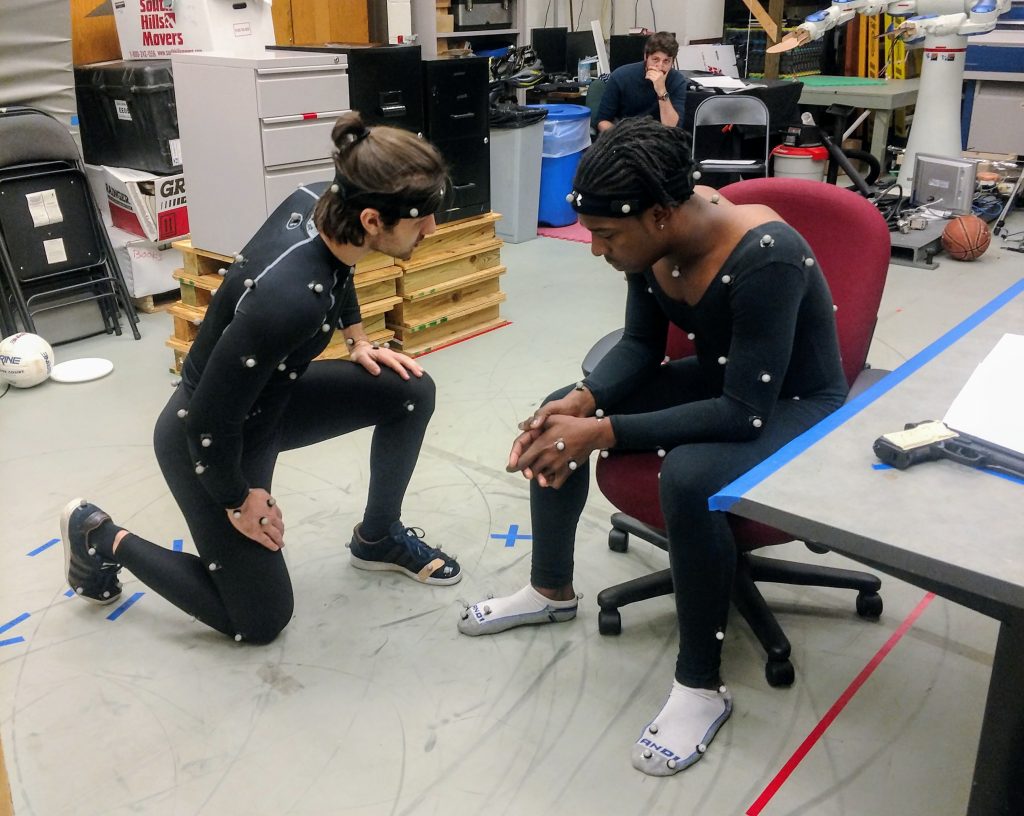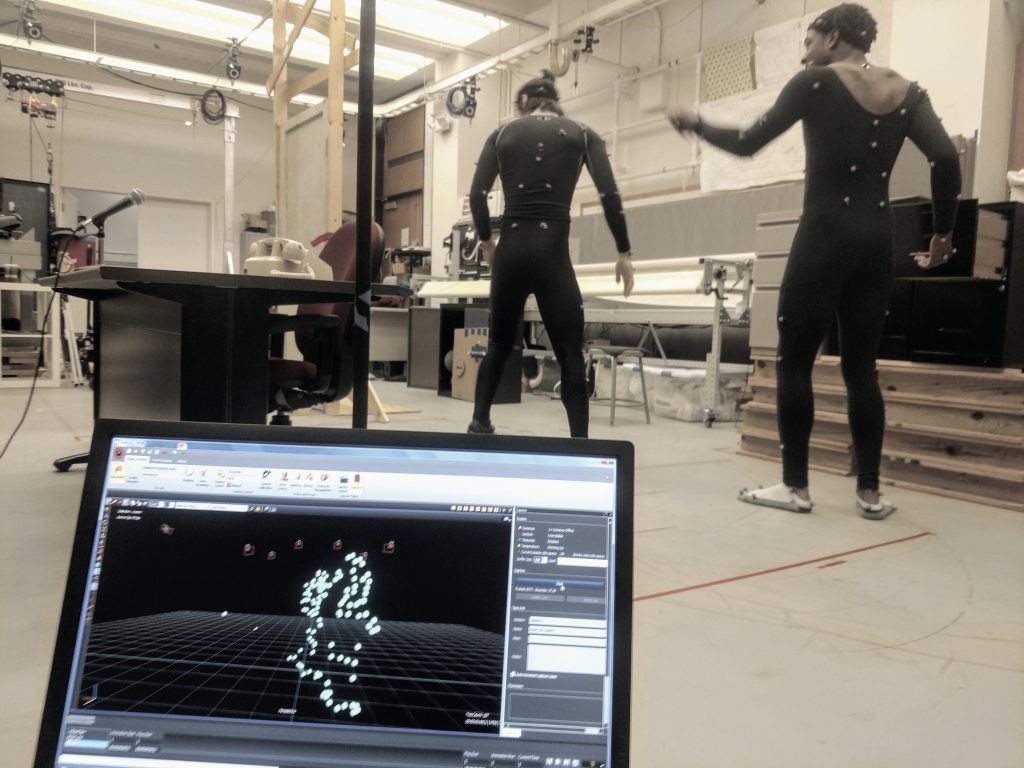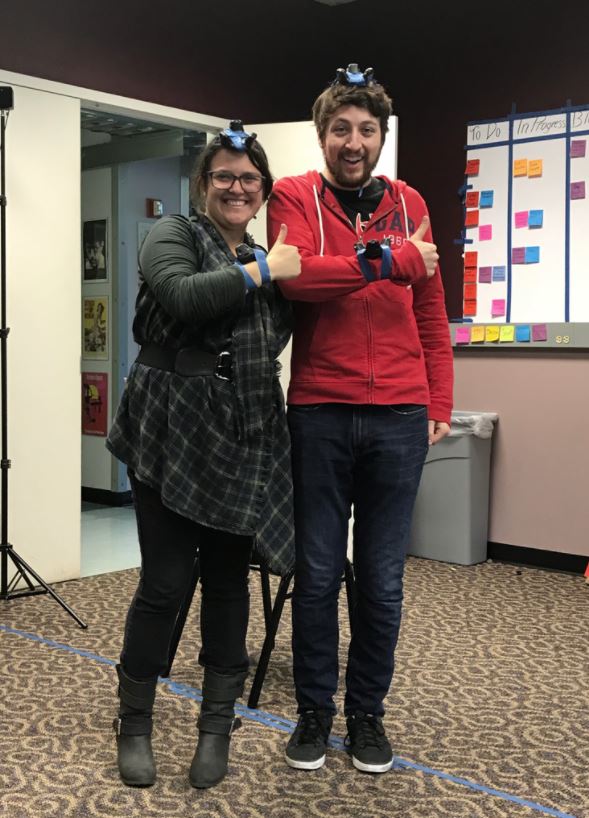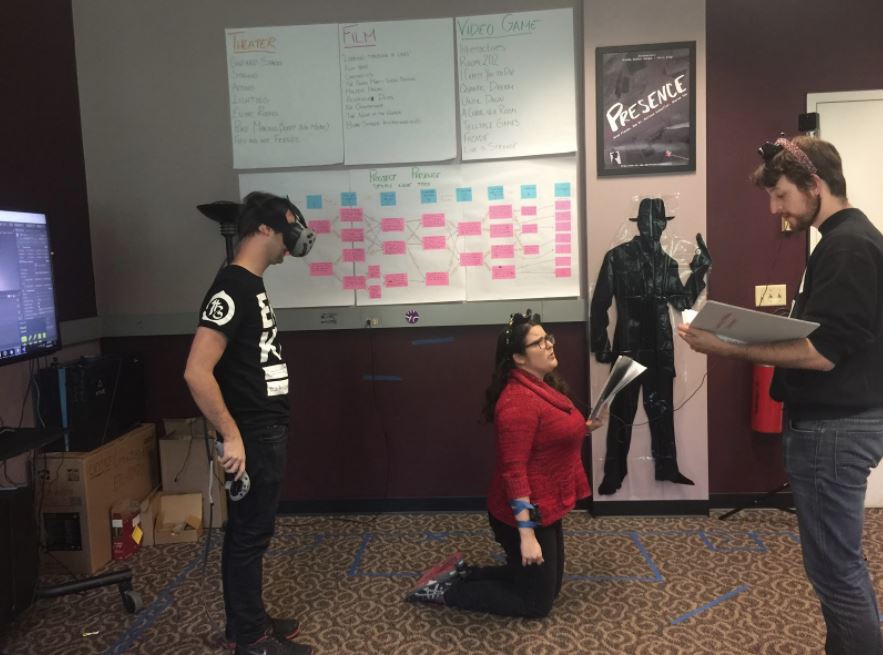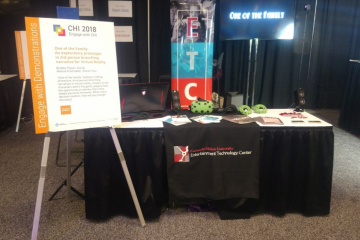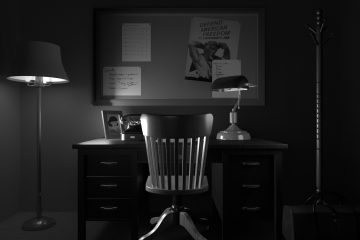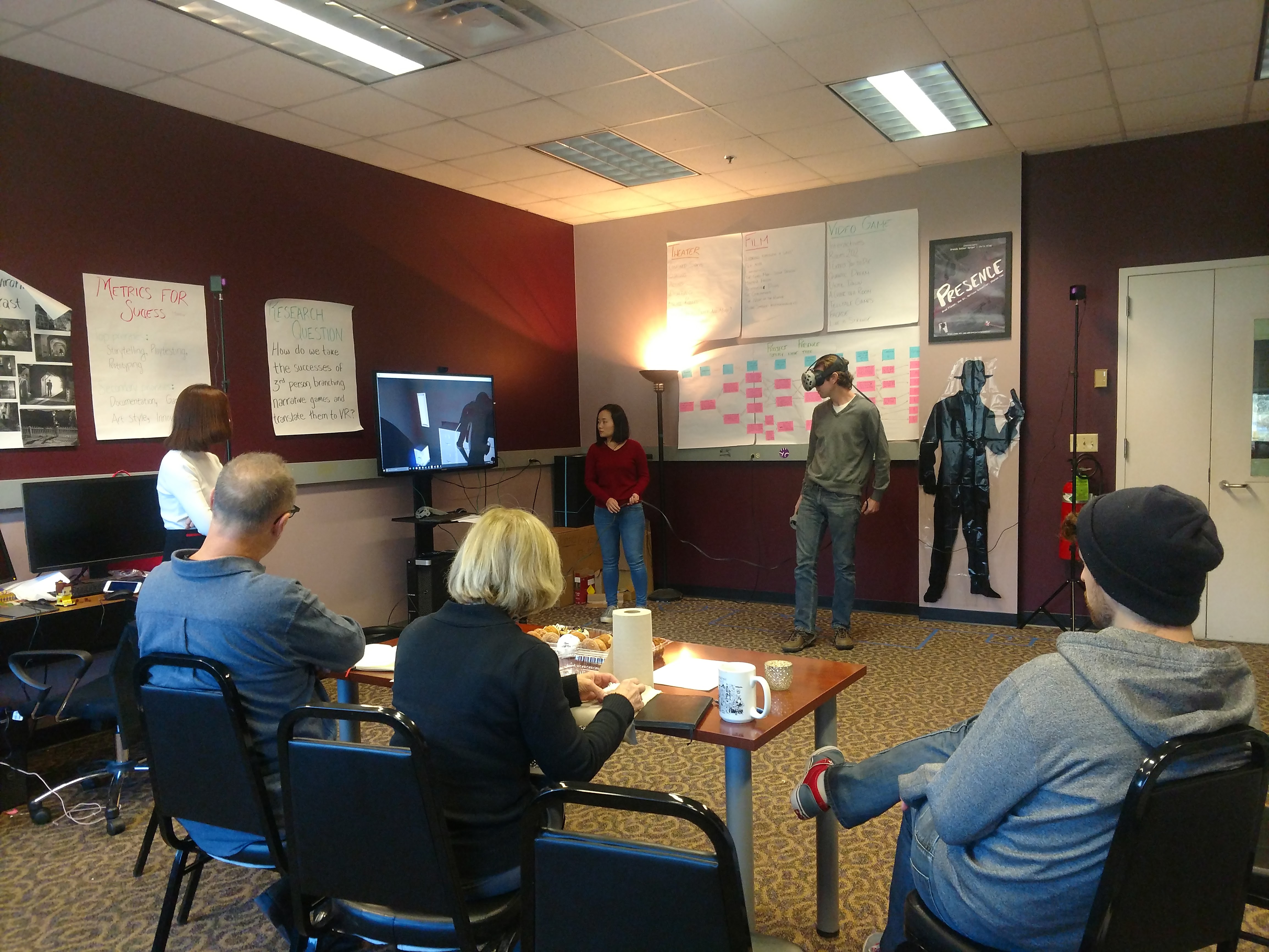We already knew this week was going to be dedicated to three things: motion capture, live VR playtesting, and mid-semester presentation prep. But, we also had a fantastic research trip!
Experiencing Full Immersion
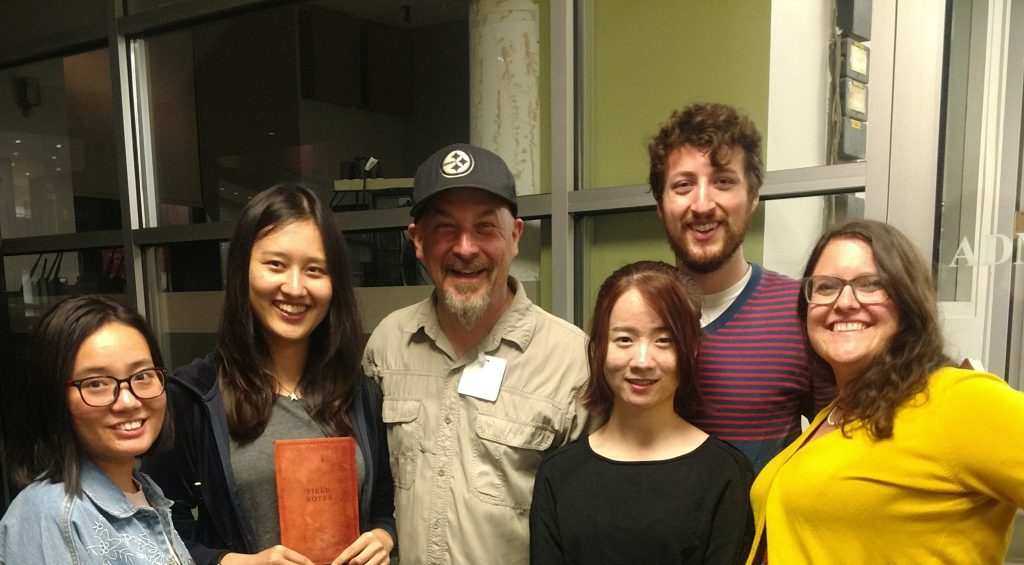
From right to left: Zoe (programmer), Ke Ma (first year), Jeffrey Carpenter (founder of Bricolage), Sharon (art director), Brad (narrative designer), Melissa (producer)
We like to say that we are somewhere in between gaming, film, and theater. The first two we researched thoroughly in the designing of our interactions and narrative, but it wasn’t until recently that we went and truly experienced immersive theater as our team. The four members of Presence, along with Brenda Bakker Harger, our instructor, and a first year, Ke Ma, attended the opening weekend of “Dodo”, a Bricolage Theater Company production.
The experience takes place inside the Carnegie Museums of Art and Natural History. Together we entered an otherworldy experience where characters guided us through exhibits, research labs, and underground tunnels. Sometimes all six of us were together, sometimes in groups of two or three, and sometimes entirely alone. We don’t want to spoil too much – it really is a show best experienced with no expectations – but the biggest takeaway was:
No two people experienced the same journey.
When the show was over, we talked with the show’s writer and co-creator, Jeffrey Carpenter, about design and process. We asked many questions about engaging the audience in the story, no matter the journey they took. He replied that it was a careful balancing act that involved plenty of iteration, but that it was incredibly important for every person to hit the same sorts of scenes, even if they weren’t in the same order. For instance, all of us experienced “the documentary,” a moment where we learned scientific stories about human-induced environmental change that led to animal death. He then said something that perked all of our ears up; he mentioned that he had a flow chart.
This inspired the four of us to gather together and compare journeys – to see if we could retrofit the flow chart based on our experiences. We knew that we all experienced a “documentary” scene, but were there other scenes with themes in common? Turns out yes – there were four: documentary, time travel, emotional connection, and a question. We each experienced different versions of these story beats in different orders. This paralleled our own flow chart, where every route goes through the same general story events. For instance, there is always a moment where Giuli will not trust Luca. There is always a moment where Giuli pulls the gun on Luca. While we had already locked in the script, this assured us that we had used the correct process in creating a balanced narrative.
Another thing Jeffrey said was essential was the importance of testing rules and threshold. Once the show was ready enough, they brought in playtesters (Guinea Pigs, he called them) who had never seen a Bricolage show before. They needed the fresh eyes to ensure that they were creating appropriate set of rules and expectations; anyone who had experienced a Bricolage show before would know what to think and how to behave, and that wouldn’t teach the design team very much about whether their thresholds were working or not.
Ultimately we as a team discussed what Bricolage did well in terms of threshold with the intention of emulating it:
- The environment physically changed
- There was physical change for the audience (objects given and taken away)
- There was symmetry within the experience between how events started and ended, and what interactions were available throughout
- The audience had to consciously participate, either through engaging in conversation or by, more importantly, actively deciding to open a door to move to the next scene
- They quickly and thoroughly established expectations for the audience of what would happen throughout the experience. The show was surprising, but never random.
These became the design pillars that we will be using to create the threshold for our own experience: Physical change, establish expectations, symmetry, and conscious participation.
Motion Capture
In other exciting news, we completed motion capture this week! We managed to get the entire thing done in a single, four-hour session. With all of the nuts and bolts of assembling this production, we soon realized that we needed every member of our crew present and working: Brad needed to direct the actors, Sharon needed to record video to give to our sound designer for reference, Zoe needed to record audio for our actors to listen to for voice over, and Melissa needed to move and catch objects that could not be pocketed in the actor’s skin-tight unitards.
That was the funny thing about motion capture that we steadily became acclimated to: It really didn’t matter who else was in the capture space and what objects got moved around, the only thing being recorded were the nodes. No one could see Melissa catch the gun Zach “pocketed.” No one could see that the cardboard safe had been replaced by a stool so Zach could sit on it.
We will soon be getting all the data, and we can finally start to build the complete game!
Live VR Playtesting
We concluded the week with the Live VR Playtest. As a recap from previous weeks, this playtest involved putting the player in the headset and strapping trackers to actors so that the scene can be played out in VR before the animations are even ready.
This process needed a surprising amount of rehearsing. Because the characters were not animated, the objects they pick up and put down wouldn’t be either. Because the characters were live, there was no precise timing for locking in choices. Therefore, in addition to having character puppet masters, we needed an environment puppet master as well. This role was filled by Zoe who, as programmer, was intimately familiar with the whole build and could most smoothly run the interactions.
The other serious shift that needed to be addressed in moving from Brown Box to VR was being able to signal to the actors without disrupting the player. Sharon would hold up signs saying which node to turn to in the script, but the problem was that unlike the Brown Box, where all objects were visible to all team members, Sharon wasn’t always able to see which choices the player made. Zoe therefore had to devise a code that signaled to Sharon in big, bold letters what the player had chosen and which node we were on.
Ultimately, the playtest went off without a hitch.
Most of the testers were very engaged with the story. They felt comfortable with their non-character player role, because they were able to relate it to other media they knew. We heard people say things like, “Oh, this is like a visual novel and I just need to take it in,” “It’s kind of like virtual immersive theater,” and “It’s basically a film.” These were huge statements for us, because they basically told us that we were designing in the right direction.
We ran into some interesting struggles in terms of false heuristics. Human brains are interesting: we establish rules for our world based on what we see and experience, even if we don’t necessarily explore. It creates phenomenon like the sense that crime is higher than it was 10 years ago, even though that statistically isn’t true – it’s just your brain training the news as the average, even though the news will mainly report crime and catastrophe.
Where false heuristics tended to bite us was in figuring out the rules of the game. We had all interactive objects glow blue. They could be interacted with any time they were glowing. If they started flashing, the player had ten seconds until the object would “lock in” and turn grey, solidifying the choice and ensuring it no longer be interactive. Players who tended to explore – who used the time before the game began to poke and prod – figured out these rules quickly. They poked objects that glowed and saw they switched. They noticed the objects flashed and then went grey. By exploring, they learned. We had two players, however, who did not explore at the start. They sat back and watch. Therefore, they determined that glowing meant, “you will be able to interact with these objects…. eventually,” and flashing meant, “you can interact with these objects now.”
We want to make sure that all players understand the mechanics, even if they don’t enjoy them. So as we move into the next playtest, we are discussing how best to handle the “tutorial” section of the game to get the rules across. Some things we are considering:
- Using a threshold environment to establish the rules
- Delaying the appearance of the characters to encourage interacting with the space before they arrive
- Having the door only begin to flash after the characters have been standing there for a minute
Below you can see one of the playtests that went especially smoothly.
As we conclude the week, we are preparing both for mid-semester presentations and for the build of our first entirely virtual playtest. Get excited!
